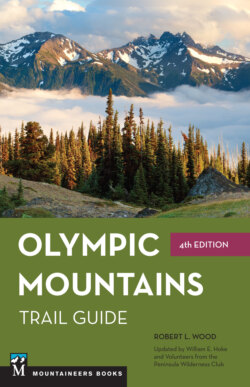Читать книгу Olympic Mountains Trail Guide - Robert Wood - Страница 13
На сайте Литреса книга снята с продажи.
THE OLYMPIC MOUNTAINS
ОглавлениеBecause they comprise a complex cluster of ridges, canyons, and peaks, the Olympic Mountains cannot be called a range in the normal sense. This cluster is somewhat steeper on the north and east than it is on the south and west. Although the terrain is rugged and precipitous, it is not lofty as mountains go, rising less than 8000 feet above the bordering seas. This fact can be misleading, however, because the Olympics stand almost as high above the Pacific Ocean as do the Rocky Mountains above the Great Plains.
This dome-like cluster does not have a central divide, but a number of ridges and so-called ranges separate the various watersheds. Some ridges are long and unbroken, but others have been eroded into sharp peaks and hanging valleys, truncated spurs and glacial cirques.
The creation of the Olympic Mountains occurred about 120 million years ago, when the land that now constitutes the Olympic Peninsula lay under a shallow sea. The peninsula has been alternately submerged beneath the sea or uplifted above it on at least five occasions, with erosion following each of the uplifts. The final rise occurred when the Puget Trough was depressed, leaving the mountains bordered by lowlands. The present-day mountains are composed of rocks that range in age from 15 million to 55 million years, thus in geologic terms the mountains are young. This uplift is chiefly composed of sandstones and shales that are closely folded and have been increasingly altered toward the interior. However, a horseshoe-shaped band of basalt encloses the mountains on all sides except the western. This band is thickest and widest in the east. Both the sedimentary rocks and the basalt were formed beneath the ocean—the former by deposits on the ocean floor, the latter by undersea lava flows. The only granite found in the Olympics, despite the reports of pioneer prospectors, is in the form of glacial erratics—boulders carried down from Canada by the Cordilleran Ice Sheet.
According to plate tectonics, the Olympics were uplifted by the movement of oceanic plates against and beneath the continent, which is not in agreement with an earlier theory that the mountains are the remnants of an upthrusted dome. Nevertheless, they do have a discernible dome-like appearance. Although the Olympics are geologically similar to the coastal chain of mountains found along the western margin of North America, they are not part of it, having been uplifted at a separate time.
The Olympics were sculpted by alpine glaciers during the last ice age. The ice carved its way down the precipitous slopes, transporting debris which was deposited at lower elevations. Subsequently, the Cordilleran Ice Sheet from Canada pushed into the basin between the Cascades and the Olympics. One ice lobe moved westward along the Strait of Juan de Fuca, another thrust southward down the Puget Trough. The ice sheet then retreated, but large alpine glaciers remained on the higher peaks.
The climate following the end of the ice age was mild for about three thousand years, and subtropical conditions extended as far north as Canada. During this warm period—which occurred about ten thousand years ago—the alpine glaciers retreated, postglacial erosion took place, and forests began to invade the country where the ice had prevailed.
The largest glaciers existing today in the Olympics—chiefly the ones on Mount Olympus and Mount Anderson—are believed by some geologists to be survivors of the ice age, but the smaller ones found throughout the Olympics are thought to have been formed during a subsequent cooling period—the so-called Little Ice Age of historic time, three thousand to five thousand years ago. Glaciers still exist on the higher peaks today, and the Olympics are noteworthy for having the lowest snow line in the United States (excluding Alaska). This line is the elevation above which snow can be found year-round. The largest glaciers in the range today vary from 1 to 3 miles in length. Although glacial carving is most pronounced on the northern and eastern sides of the mountains, all the larger valleys and canyons have been deepened and steepened by glacial erosion.
